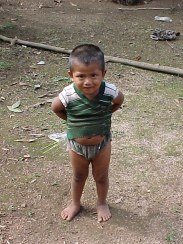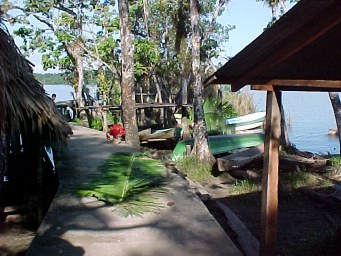The Cruising Adventures of Joan & Ben Schuetz aboard | home
Part 10: The stressless life
Well, we've been on the river, at the dock at Mario's, since the 15th of January and it's showing on our middles. It's a pretty lazy life with good food, good beer, and nothing much to inspire or goad one into doing anything. The river has been quiet; having had no nefarious activities for many weeks. Every day or so, a boat or two will come or go and those of us who are not on the move, seeking excitement, look to see who it is. During the day, it generally gets in the high 80s and at night down in the high 60s low 70s. When it rains during the day, it is usually brief, but in the evening, it sometimes lasts all night. This is Pleasantville and we have separated those things that are unpleasant from those that are pleasant.

We have visited the village, Las Brisas del Golfette several times. Maria and Norm returned from a weeks vacation in Antigua, in the highlands, and we got together to transfer the things Sue Callahan (Joan's sister) and others had provided. Together with things that we came up with, the stuff had filled our V berth. To say the least, Maria and Norm were delighted. Nothing will go to waste. Any clothing that cannot be worn will be salvaged for the cloth to become something else.


The village is doing well. They now have a full time teacher for the new school; salary about $200 per month. Other new additions are: a generator to supply power to the small clinic and church, an engine driven water pump to intermittently pump water from the river to a storage tank where the water is purified with a small quantity of Clorox and alum. The village is clean and health conditions continue to improve. There are several small teams of volunteers coming from the US to visit in February, March and April. The volunteers are comprised of health workers, medical students, and other caring people. Maria and Norm are pretty clear on not just giving things to the villagers. Each one must help to improve the community in some way. So, many of the women sew or weave, while the men work in teams to replace older huts with newer, improved construction. Their typico homes are built with cane, palm fronds, and corner support timbers and can be built in a few days.







One of the village men was just finishing a new cayuca (dugout canoe). It was about 12 or 14 feet long and carved from a single tree trunk. We asked how long it takes to make one and the best answer we could get was "mucho tiempo", a long time. Norm said that it often took months to make one. Yet, if anyone would wish to buy a similar cayuca, they can be purchased elsewhere on the river for less than $200. We are told that the average Guatemalan's salary here on the river is about $5 per day. The villagers make substantially less. While that may sound depressing, life here is simpler, more leisure, and relatively easy. Health care has been one of the biggest problems and that is improving with the help of people like Maria and Norm.



Many of our friends here at the marina are doing inland travel. Guatemala is a wonderland of sights and experiences. We, however, have done it so many times and have decided not to go again. Next Sunday, however, we are going to visit another Q'eqchi or Kek'chi (many spellings) Mayan Village that has only recently been adopted by Maria and Norm. It is somewhat more remote, being on the shores of an isolated little lagoon in the northeast corner of Lago Golfette. When we return to the States, I will publish lots of pictures on the web site.


A few days ago, on the NW Carib. Net, we heard of yet another sailboat being lost. The captain and mate are alright, but the boat was totaled. They had been anchored on the north shore of Honduras near Cabo Gracias Adios. Sometime during the night, their anchor line broke and they were washed ashore. Communicating on the Net, they said that while they were taking on a little water, it was under control. They were hard aground in sand and needed to be towed off. The US Coast Guard has a drug interdiction presence in the Gulf of Honduras, but so long as there was no danger to life or limb, they could not respond. Sometime during the day, the Honduran Navy pulled them off, but the next day we heard the boat had sunk from apparent hull damage.
That was the third sailboat lost within two months. Considering there are, at most, a couple of hundred boats cruising these waters and mostly in marinas, that is not a good record. Although the last foundered sailboat was perhaps a hundred miles from the nearest group of cruisers and the Net was helpful in communicating with the US Coast Guard and others, I am disturbed that there was no physical help from the cruising community. We offered to go help, Francesca having the necessary muscle, but as it would have taken about 36 hours to get there it was not a practical solution.
In the States, boaters have the attitude that other boats in trouble can call TowBoat US or some such. I think this has come about because of the potential for damage and law suits, but more so because it is easier to let someone else do it. Out here, there is no one else. We need to help each other even when it is inconvenient to do so. (Soapbox speech #42).
Back here at Mario's, Joan and I have enlisted the help of Monica, a Guatemalan senorita, to give us Spanish lessons. She is very good and we are progressing well. When shopping it is so nice to ask and understand without appearing completely stupid. We plan to remain in the Rio, at least for the next couple of weeks, and soak up as much Spanish as possible.
Future plans remain etched in Jell-o. We do intend to spend a month or more at the Bay Islands of Honduras, Utila, Roatan, Guanaja, and then perhaps continue south to the Columbian Islands of Providencia and San Andres. These later islands are 60 miles or so off the coast of Nicaragua and reported to be safe havens. Then, if moved to do so, we may continue south to Panama. There is so much uncertainty in these plans that they are not worth much. Just mentioning it in case you are interested in looking ahead some. With a little searching on the web, I'm sure there are many sites with interesting information.
Joan, Ben & Maggie













